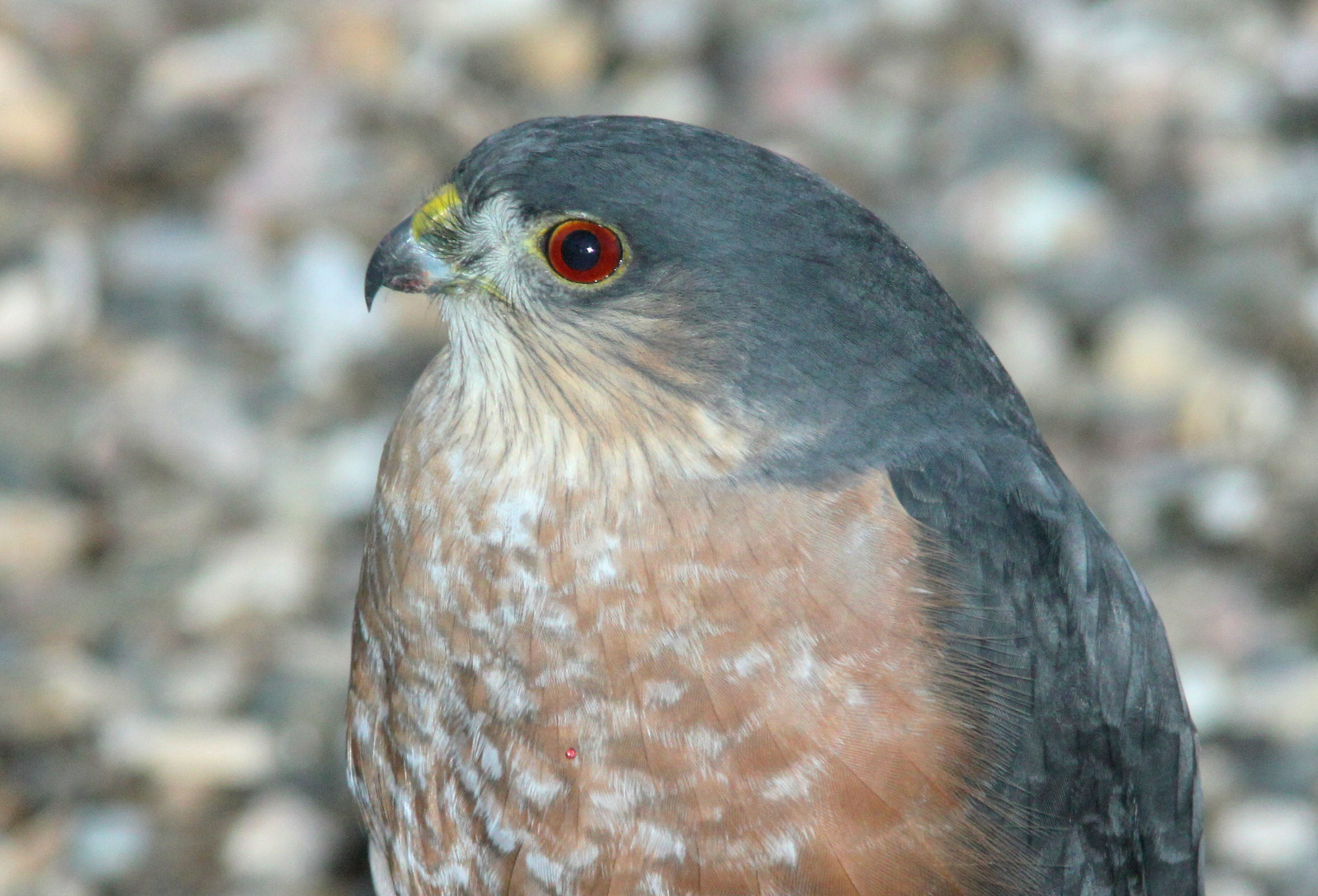On a winter day just after a blizzard, Bryan was cleaning the snow off the bird feeder when a small hawk swooped past him. At only three feet above the ground, the little raptor skimmed between the house and the bird feeder and glided up to perch in one of the elms in the north fence row. What was this little raptor doing so close to a human? And so close to the house? Although he didn’t have time for a full evaluation of the bird, Bryan thinks it was a sharp-shinned hawk (Accipiter striatus)—the smallest of the hawks that are found in Iowa. Perhaps she was on a migratory trek from the northern conifer forests to warmer climes and stopped by Owl Acres hoping for lunch. Bryan had already dispersed the birds at the bird feeder, so lunch eluded her this time. 90 percent of her diet is little songbirds like the juncos and finches that flock together on Owl Acres. If she’s migrating, she’s late in the season.
She gets her name because of a ridge of skin running down the front of each long, skinny yellow leg. Her feet are yellow, too, with an extra-long middle toe that helps capture prey. Males are generally bluish to slate-gray on their backs and wings with a darker head and white underparts. Our female is more brownish in color. She has rounded wings spanning 23 to 26 inches and a squared-off tail. Her eyes are a deep red ringed in yellow. She has a hooked beak, and the darker feathers on her head and neck give her a hooded appearance. She weighs up to seven and a half ounces and is 40% bigger than her male counterpart. She’s about the size of a crow, and he’s about the size of a blue jay. Sharp-shinned hawks are often confused with their close relative the Cooper’s hawk, which leads a similar life but is bigger and has a longer, more rounded tail.
Sharp-shinned hawks breed in northern conifer forests. They are very agile flyers swooping and careening through the branches. The one visiting Owl Acres exhibited her skill weaving through the yard, propelled by three to six very rapid wing-beats powering a graceful glide. In the forest, she uses her tail like a rudder to guide her flight.
Many hawks and other birds of prey wait high above the ground until they spot a likely dinner. Then they plummet to the ground in a controlled dive. The Sharp-shinned hawk has a different approach to hunting. She waits near the ground for her prey, then flashes out of hiding to grab it in mid-air in her long talons. Before she eats it, she will take it to a spot where she can pluck its feathers. Although small songbirds are her primary food, she is not averse to eating mice, voles, crickets, or larger prey. Larger birds of prey are not averse to her, either. Bald eagles, peregrine falcons and northern goshawks find her palatable.
In the summer, she lives deep in the northern forests. She builds a nest high in a conifer, and after mating she lays a clutch of four or five eggs. Before the little ones go off on their own, the adults teach them to accept food while in flight and in time to hunt on the wing as well. By fall, some populations get ready to migrate south, some as far as Argentina. Although they are generally solitary birds, they will form small flocks during migration. Some also breed farther south and don’t migrate at all.
Sharp-shinned hawks are native to the Americas. They are protected by the Federal Migratory Bird Treaty Act. The laws didn’t help, though when, between 1940 and 1970, DDT was routinely used as a pesticide. DDT caused thinning of the shells of their eggs, which made them crack prematurely, or collapse under the weight of the incubating parent. Their population declined considerably during that time. DDT is no longer used in the United States, and the population of sharp-shinned hawks has rebounded, and they are not considered endangered.
The birds at our bird feeder are no doubt happy that this little raptor has moved on. For us, it was a real treat to be introduced to a new visitor.
Photo from Wikimedia.org by Alan Schmierer. Alt text: Head shot of a small raptor. Sharp-shinned hawk is blue-grey on top and white-tan underneath. Round head, red eye faintly ringed in yellow. Short, hooked beak.
